Yellow Sea
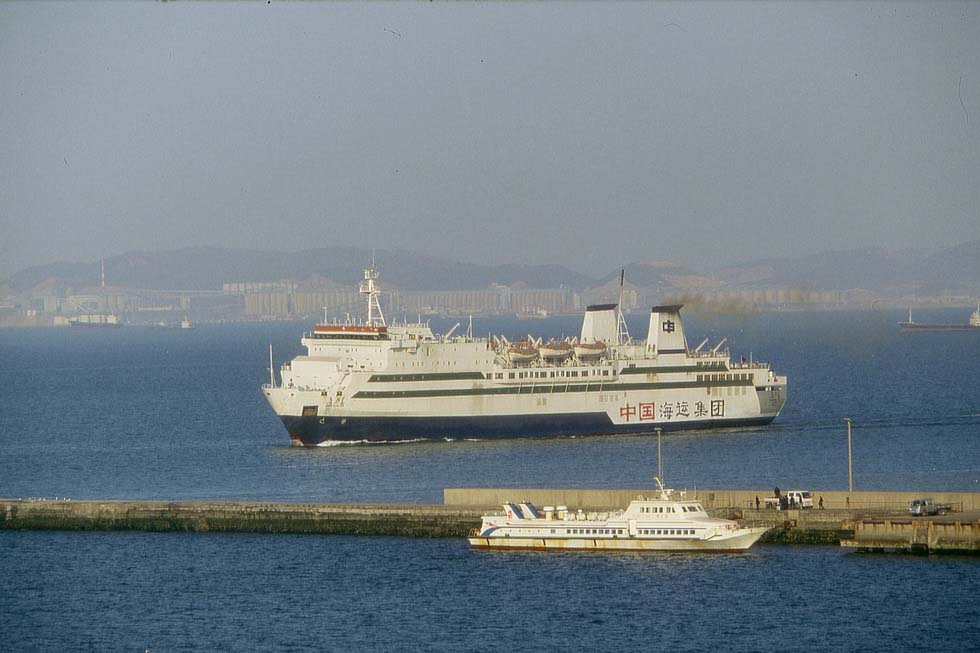
"Chiang Chin Dao" of China Shipping Passenger arriving at Dalian, 2011 (WS)
Manchuria, the Chinese region north of the Yellow Sea, was in the second half of the 19th century submitted by Russia. In 1894 the Japanese seized Chinese warships at Port Arthur, the colonial powers ceded the peninsula to Japan, but Tsar Nicholas II did not agree. In 1898 it was concluded to submit the Liaoning province with the Liaodun peninsula and the icefree harbour of Dalian (Dalni) on the east coast of the small Guandun peninsula to Russian dominance, with the military administration located at Port Arthur.
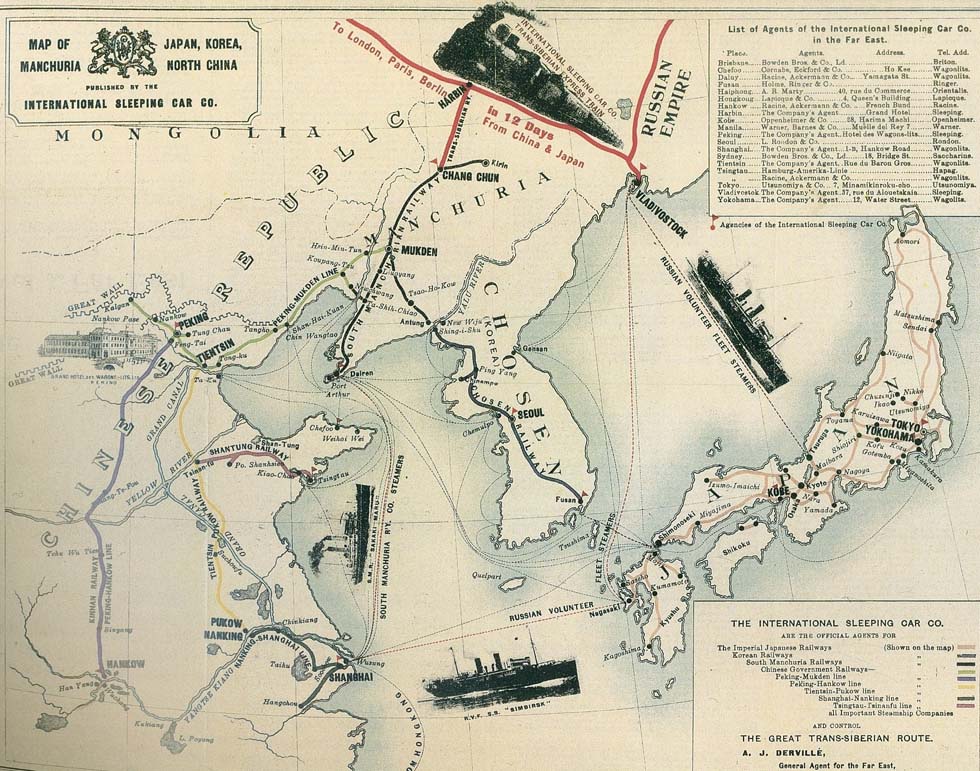
Yellow Sea and Japan Sea before WWI (coll. Jean-Paul Caracalla)
The Way from Europe
Beginning with the 20th century, the fastest way from Europe to China and Japan was not by ocean liner, but by the Trans-Siberian railway (see www.trains-worldexpresses.com). In 1896 a contract was concluded between the Russo Chinese Bank and the Chinese government to found the East Chinese Railway, using Russian broad gauge. In 1898 the "Imperial Chinese Government granted the Company permission to continue the construction of the railway from (...) the Manchurian line to Da-lian-van and Port Arthur (...) which received the name of South-Manchurian branch of the East Chinese Railway", so reported by the official 'Guide to the Great Siberian Railway', published in 1900.
Dalian was connected since 1902 by rail and from 1903 the passenger connection from Russia to the harbour of Dalian with several changes of train was reported. At Dalian the passengers could take a steamer of the East Chinese Railway to Japan. The official Guide of 1900 stated that the railway has "...obtained the right to establish a special ocean steamship navigation in the Far East". Concerning this Ocean Steamship Navigation Co., the report continued: "In 1899, voyages were accomplished by 6 steamers belonging to the company, 3 freight steamers, 2 goods and passenger and 1 passenger steamer. (...) By this time it owns wharves at Vladivostok, Port-Arthur, Dalni, Chifu, Inkou, and in the near future (...) Shanghai." The "Russian" road in nowadays' Dalian and possibly some abandoned rail track on the pier are still remainders of that Russian epoch, which ended abruptly with the war started by Japan.
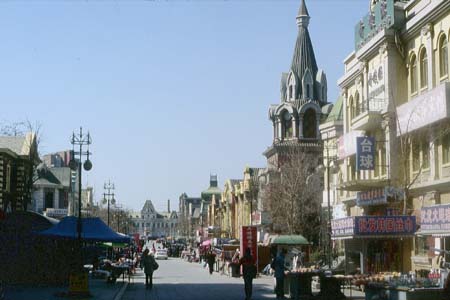 Dalian, the 'Russian' road (WS)
Dalian, the 'Russian' road (WS)
The Japanese-Russian war of 1904-05 interrupted every service and further on the whole region of South Manchuria was Japanese-occupied. A Russian 'Courier' express from Moscow straight to Dalian must have been a dream, now prevented for ever. From 1910 the "Transsiberien" express of the Wagons-Lits company had a branch to Changchun (Hsinking), where already since 1908 a Japanese South Manchurian express departed for Dalian pier. The rails to Dalian had been changed in 1907 from Russian broad gauge to standard gauge. At Dalian the steamers of the South Manchuria Railway connected with Shimonoseki and other ports. From 1918 the way from Russia to Dalian was interrupted and for the connection further on via the Soviet Union see the chapter Japan Sea.
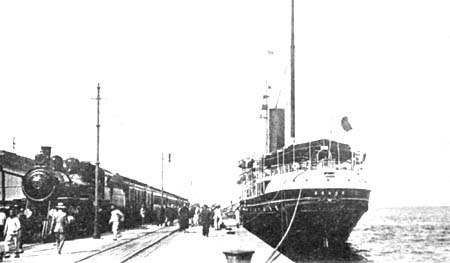 Express of South Manchuria Railway after arrival at Dalian and the "Saikvo Maru", bound for Japan (coll. A. Lengelle)
Express of South Manchuria Railway after arrival at Dalian and the "Saikvo Maru", bound for Japan (coll. A. Lengelle)
Japan's victory of 1905 has provided also the occasion for the Nippon Yusen Kaisha to start services Dalian - Shanghai with the "Kobe Maru" of 1908. Later the "Sakaki Maru", a two-funnel liner of the Japanese South Manchuria Railway, followed. An advertisement of the South Manchuria Railway, published by Bradshaw's Guide of 1914, praised "the fast Passenger and Mail Boats, 'Sakaki Maru' and 'Kobe Maru'. Both steamers are thoroughly equipped with the latest facilities for the comfort and safety of passengers, including wireless telegraphy, and a highly qualified surgeon is carried on each."
A German map, probably of 1914, showed also routes from Qingdao (the German protectorate Tsingtau), Yantai and other Chinese ports to Dalian. Korea, conquered by Japan already in the 1890s, was reached by steamer services from China to Incheon, at that time named Chemulpo. This harbour had been opened to foreign trade in 1883. Since 1900 it is connected by rail with Seoul.
The South Manchuria Railway introduced in 1934 between Changchun (then temporarily also Harbin) and Dalian the streamlined prestige train 'Asia'. Already in autumn 1931 Japan had occupied also the North of Manchuria, then forming a part of the satellite state Manchukuo under the 'last Kaiser' Pu Yi. The formerly Russian-owned Chinese Eastern Railway became the North Manchuria Railway, the connection Manchuria - Vladivostok was interrupted and until 1938 change of the entire rail network to standard gauge was completed. A new line was opened in 1935 to Rashin (now Najin in North Korea), a harbour of strategic importance, close to the Soviet border. It is not known if its shipping connection with the Japanese west coast was only for military purposes.
During World War II the Soviets were not on the side of Mao Zedong and with the Yalta conference in February 1945 it was decided to cede Manchuria to the Soviets. With the treaty of August 1945 Chiang Kai-shek had to recognize it and the Chinese Changchun Railway was subordinated to the Northeast Economic Mission under Chiang's former minister of transport. Obviously, official sources asserted protection against the Japanese, but other reports suggested protection against Mao. On 1st October 1949 however, Mao Zedong could proclaim the People's Republic of China, in December he traveled by train to Stalin, in February 1950 the treaty of friendship was signed, in 1953 the Changchun railway was handed over to China and in 1955 the last Soviet troops left Port Arthur by Chinese trains. Some official buildings on the former Stalin square of Dalian are the last Soviet heritage.
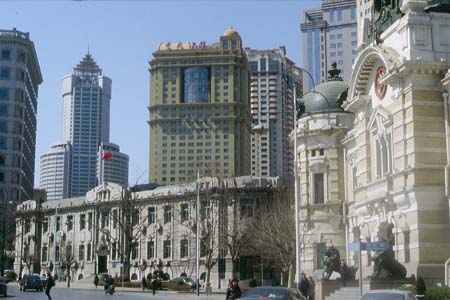 The former 'Stalin' square in nowadays' Dalian (WS)
The former 'Stalin' square in nowadays' Dalian (WS)
Bo Hai Strait Ferries
Cook listed still the conservative long routes from Shanghai and Qingdao to Dalian, but the shortest way of connecting the center of China with modern Dalian in the north is by crossing the Bo Hai Strait, with Yantai and other harbours, also Tanggu, as ports of departure. Tanggu was the old harbour downstream from Tianjin (Tientsin), the sea trade center for Beijing since the 1860s. Before WWII, the Japanese initiated to build a new harbour there, completed in 1952, known as Xingang.
From Mao's time on, shipping was government-organized and later state-owned COSCO has become one of world's biggest container shipping companies. Still in the 90s, for COSCO were registered (according to Ortel/ Foerster) the "Tian E" (the former "Dana Sirena" of DFDS), "Tian Kun" (the former "Prins Bertil" of Lion Ferry) and the "Tian Peng" (the former "Munster" of British & Irish). A report by Klas Brogren (editor of Cruise & Ferry Info, published by the German magazine Ferries, March 2009) provided newer information, listing also the "Dong Peng 1" (the former "Georgios" of Fragline), all these ships having gone to the scrapyard. Since the catastrophe of the 48 years old formerly Japanese car-ferry "Dashun" in 1999 there were enforced safety regulations.
At the turn of the century the largest ferries on the Bo Hai Strait were the ro-pax vessels "Bang Chui Dao" and "Hai Yang Dao" (1995/15,560gt, built in the Netherlands) of Dalian Marine Transport, a COSCO daughter. Ortel/ Foerster had reported an initial intention of Korea services. From 2001 the ships were registered together with consorts for the China Shipping Passenger Liner Co., operating mainly between Yantai and Dalian. The "Hu Luo Dao" and "Pu Duo Dao", half-sisters of the Dutch-built ro-pax vessels, and four ships of an extended version followed from Chinese shipyards. An older ship, the "Chiang Chin Dao" (1982/17,961gt, the former "El Greco", then "Capo Sandalo" of Italy), served Weihai - Dalian, another way to cross the Bo Hai Strait. For passengers only, the catamarans "Hai Luo" and "Hai Yan" were introduced.
Two conventional passenger ships were employed by China Shipping Passenger on the longer route Xingang - Dalian. Tianjin, c.60 km distant from the harbour Xingang, developed into a modern commercial centre with 11 million inhabitants. It is connected with Beijing by high-speed trains, since 2009 covering the 118km within half an hour at a top speed of 350km/h, some trains serving also the harbour city Tanggu.
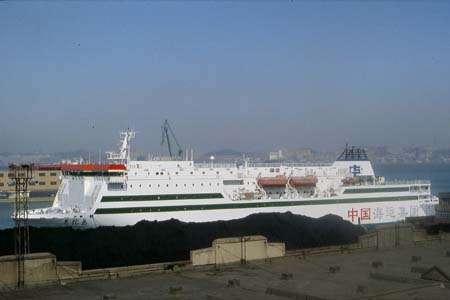
"Pu Duo Dao" of China Shipping Passenger, Dalian 2011 (WS)
|
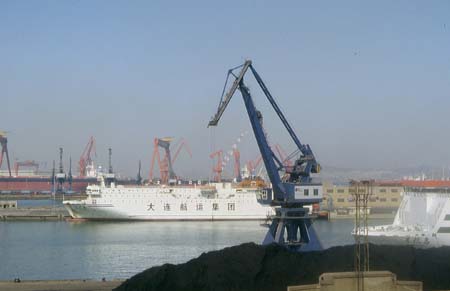
"Wan Dong Hai", Dalian Shipping (?), Dalian 2011 (WS)
|
Province-owned Dalian Shipping relied for a longer time on second-hand tonnage from Japan, but commissioned newbuilds, too. Klas Brogren reported: "In 2008 the company has introduced the newbuild "Wan Rong Hai" (...), a version of the "Sheng Sheng I" of Weida Ferry (....) With Dalian Wantong Ronghai Shipping, together with the Dalian Port Group and Dalian Marine Transport Group, a new company was founded and for it a second newbuild "Wan Tong Hai" was commissioned...".
As a successor of Yantai Marine of the Shandong province, the ambitious enterprise Shandong Bohai Ferry or Bo Hai Ferry Co. was founded in 2001 as a company to be privatized. With the ro-pax "Bo Hai Jin Zhu" (2006/24,024gt) and sister "Bo Hai Yin Zhu", older predecessors were surpassed in size. They were followed by the "Bo Hai Zhenzhu", "Bo Hai Yuzhu", "Bo Hai Baozhu" and "Bo Hai Freiu" as the largest ro-pax ships built in China.
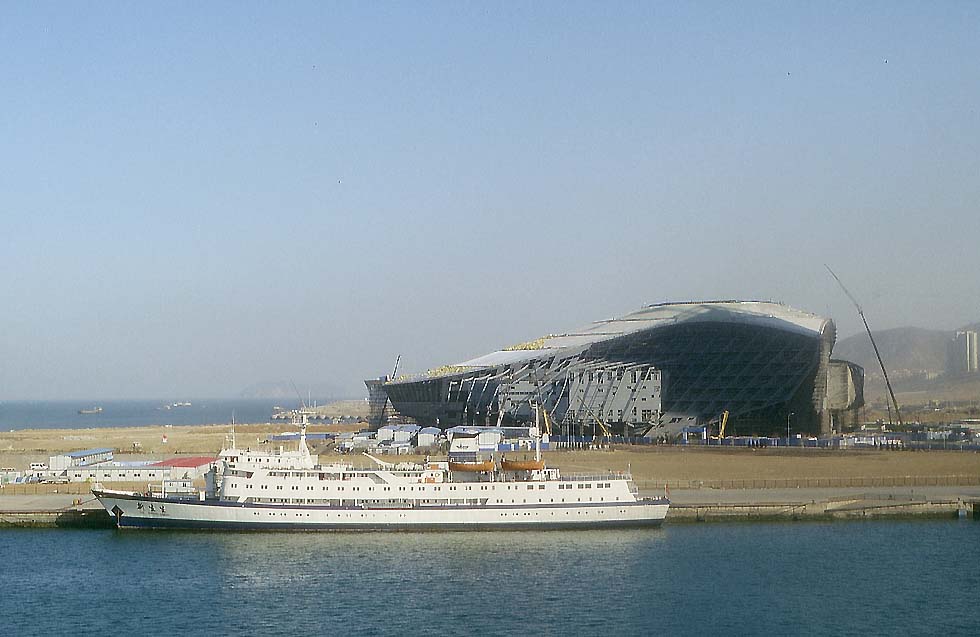
"Xin Sheng Sheng" of Weihai Haida, Dalian 2011 (WS)
On the route Weihai - Dalian, Weihai Haida Passenger Transport has introduced the "Sheng Sheng I" (2006/10,347gt). Zhong Tie Bo Hai took up freight train conveyance between Yantai and Lushun in 2006 with the "Zhong Tie Bo Hai 1 Hao". Lushun is the former Port Arthur, c.45km distant from Dalian (see chapter train ferries). Hi-speed services on the Yantai - Dalian route were started by the Shandong Province, by Dalian Yuan Feng Ferry and by the Dalian Passenger Shipping Co.
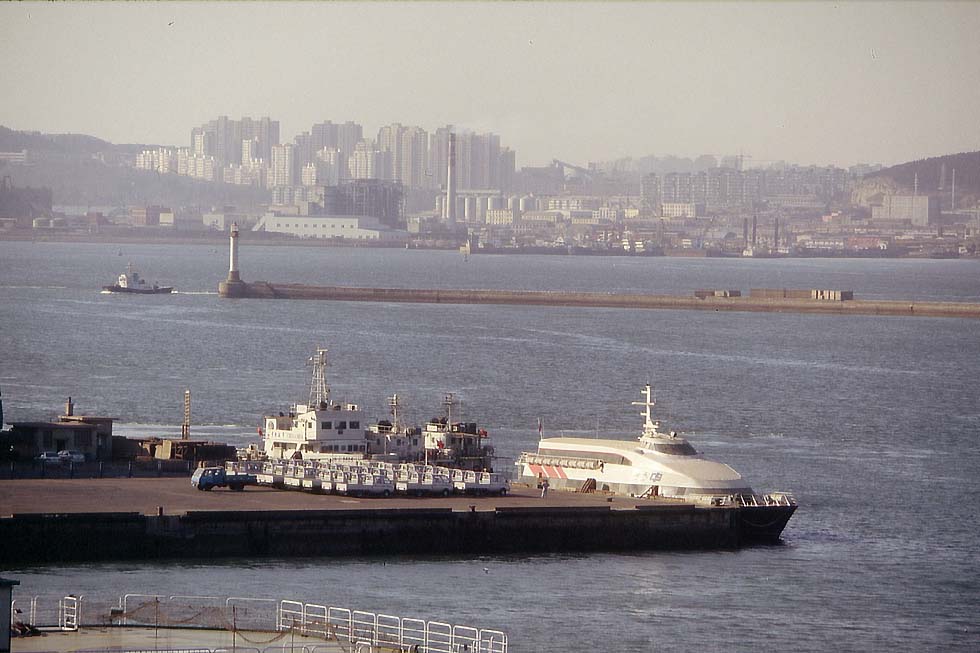
Dalian and a China Shipping Passenger hi-speed, 2011 (WS)
China - Korea Ferries
The bloody Korean War, started by the communist world in 1950, ended with a ceasefire in 1953. Incheon was the place where the Marines under General MacArthur made a successful landing behind the North Korean spearheads. Later, South Korea became one of the economic 'Tigers'.
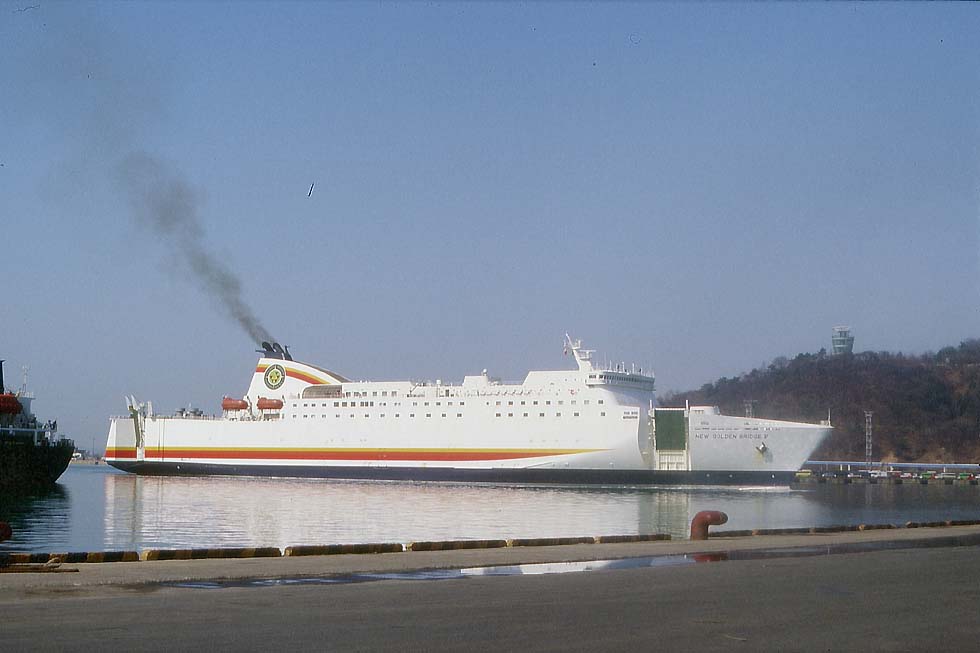
"New Golden Bridge V" of Weidong Ferry arriving at Incheon, 2011 (WS)
Almost twenty routes to South Korea are served by a dozen companies in international cooperation. Traditional Korean harbour is Incheon, protected against tides by locks. Suburban trains provide the connection with the capital Seoul, c.40km distant. Also a new Incheon International Seaport and a 27km long bridge for connecting the new Incheon International Airport were built.
Chinese and South Korean investors founded in 1990 the company Weidong Ferry for pioneering the China - Korea route. Qingdao and Weihai were connected with Incheon. The ferries carried, apart from passengers, mostly containers. The Weidong Ferries have "New Golden Bridge" names, the largest with 29,554 tons having been number II, built in 1990 as "Rainbow Love" in Japan (according to Brogren). Number III was sold in 2004 to Greek buyers, VI was acquired in 2008 from Japan (built in 1987 as "Oarai Maru").
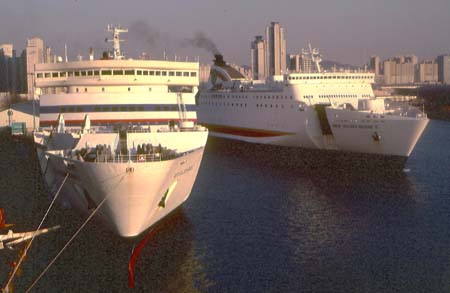
"New Golden Bridge II" (left) and the departing "New Golden Bridge V", Incheon 2011 (WS)
|
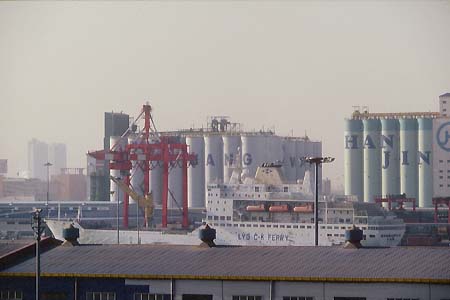
A vessel of Lyg C-K Ferry, Incheon 2011 (WS)
|
According to K. Brogren, Shandong Bohai Ferry intended to introduce ships with a higher lane metre capacity on a route from Qingdao to Pyongtaek, south of Incheon. During the first decade of the new century, among the largest ships was the 26,463-ton "Tien Ren" (ex "Blue Zephyr") of Tianjin-Incheon International, employed between Xingang and Incheon on the longest route. Almost as long is the route from Shanghai to Mokpo, served by Four Seasons Cruises. That city is connected with Seoul by high-speed trains. A conventional passenger-cargo ship is the "Xiang Xue Lan" (1966/16,071gt), employed between Yantian and Incheon by C-K Ferry, like sister "Zi Yu Lan" built in Germany. For a connection between Yingkou on the Liadong Wan Bay and Incheon, Pan Korea Yingkou took over the "Arafura Lily" (1996/12,307gt), a conventional passenger-cargo vessel, built in the Netherlands. By 'Die grossen Passagier-Schiffe der Welt', the confusing career of that ship was described, being built as "Zi Ding Xiang", introduced as "Arafura Lily" between Brisbane and Singapore, then operating for Shanghai Hai Xing and later for the Incheon International Ferry Co. between Shanghai and Incheon. That source mentioned also the similar "Yu Jin Xiang", then employed by the Qin-In Ferry Co. between Qinhuangdao on the Liadong Wan Bay and Incheon. Other routes to the Korean west coast, listed by K. Brogren, were Rizhao - Incheon by KC Line, Shidao - Incheon by Huadong Ferry, Rong Cheng - Pyoengtaek by Dalong Ferry and Dalian - Incheon by Dalian Ferry with the "Da-In" (1988/12,365gt), the former "Venilia" of Japanese origin. In 2011 the "Da-In" was seen with the label Da-In Ferry. Years before, ShipPax had listed also a route from Rizhao, south of Qingdao, to Pyoengtaek by Seyang Shipping.
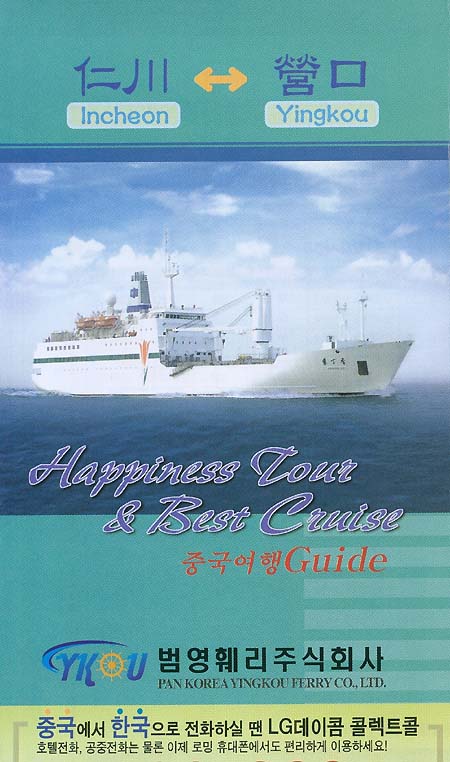 Pan Korea Yingkou Ferry (ad 2009)
Pan Korea Yingkou Ferry (ad 2009)
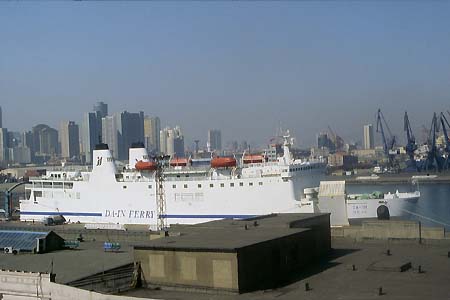
"Da-In" of Da-In Ferry, Incheon 2011 (WS)
|
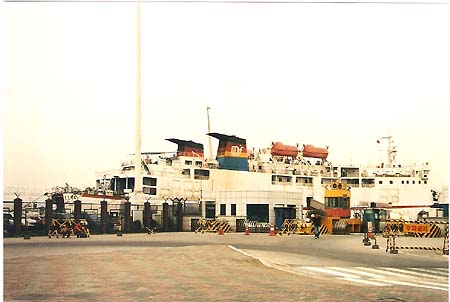
Dandong Ferry, Incheon 2009 (Heiko Mueller)
|
New activities are emerging, though during decades the military tensions were a permanent threat. A service by Dandong Ferry from Dandong to Incheon has a route close to North Korea. Dandong, the former Antung, is the Chinese border station on the railway to Pyongyang. Who wants to see North Korea from 20 metres distance, can take at Dandong one of the daily boats on the Yalu, the river which marks the border of that isolated country.
Generally the history of car ferries around China and the neighbouring countries is so complicated, that only a short glimpse mainly on the situation in the first decade of the 21st century can be caught. A steady upgrading would go beyond this worldwide survey. Names of the numerous companies changed in some cases and spelling of ships' names is varying dependent on sources. Always changes occur and in consideration of China's rise to world's economic powerhouse, development of the car ferry business to an unprecedented growth must be expected.
|